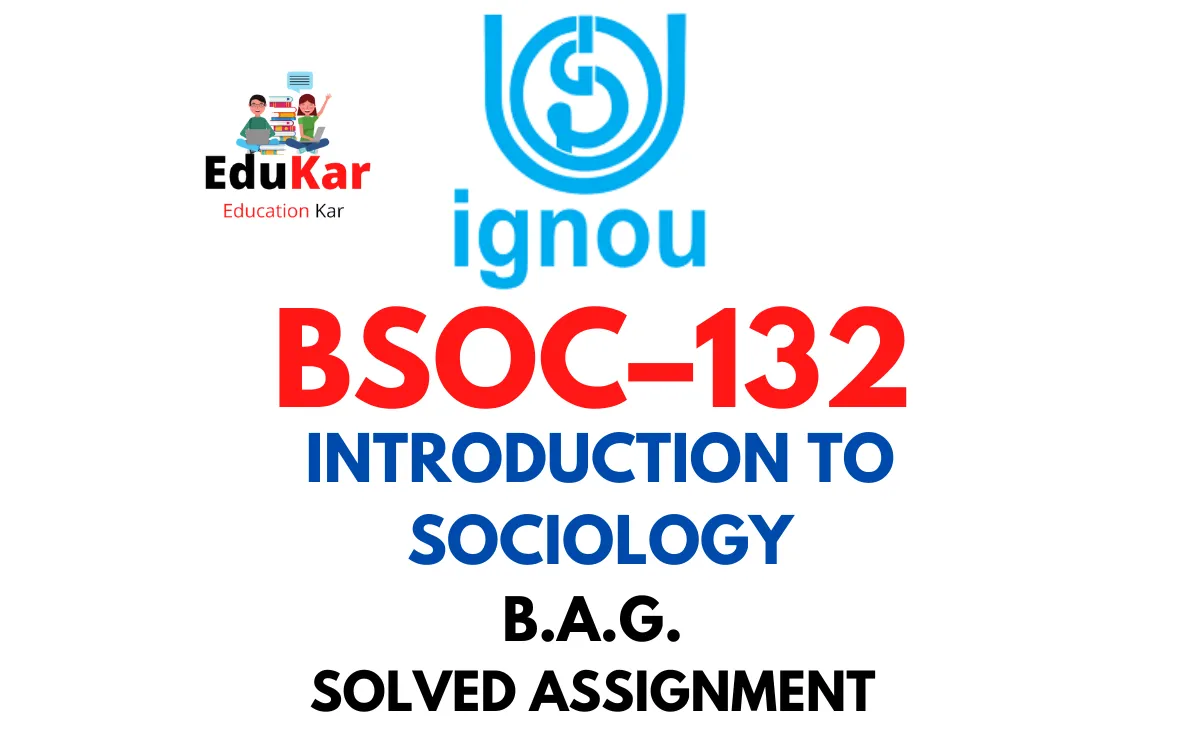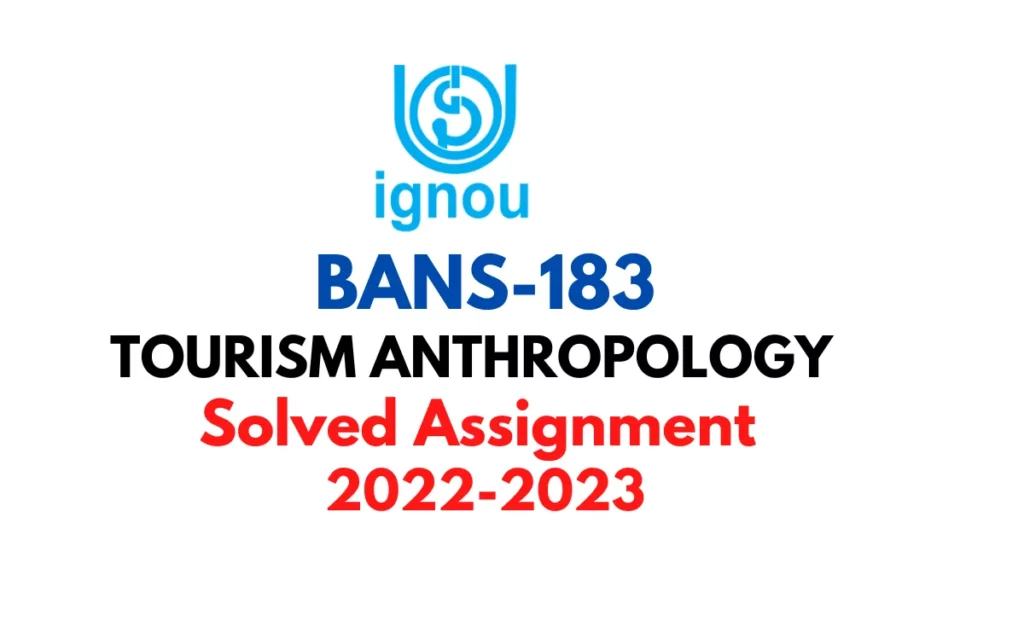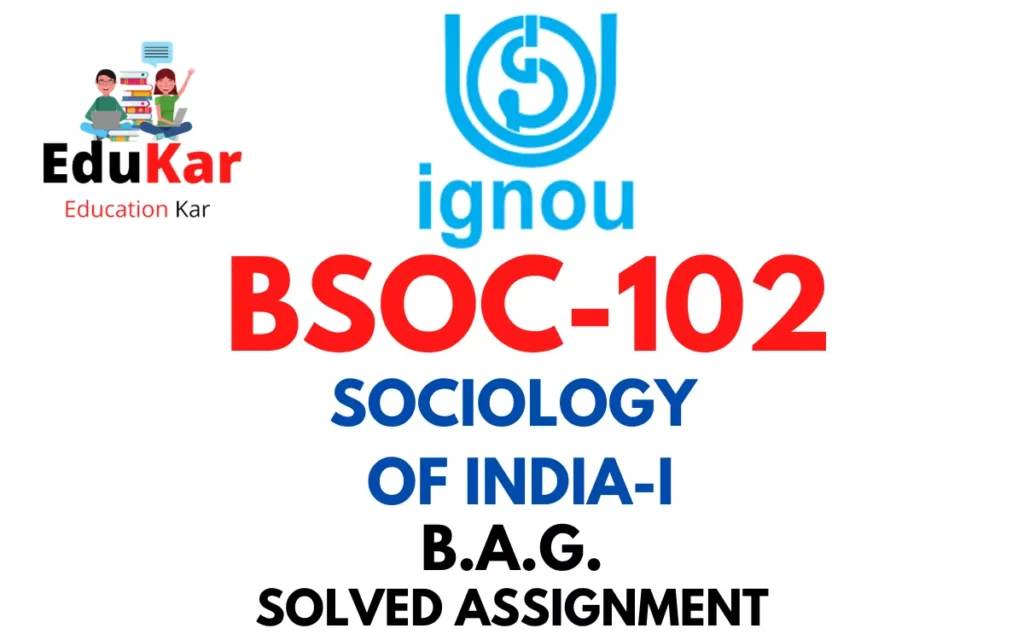Contents
- 1 Assignment One
- 2 Answer the following Descriptive Category questions in about 500 words each.
- 3 1. Discuss the bonds of unity in India with suitable examples.
- 4 2. Define the concept of ethnic and discuss one of the tribal ethnic movements in India.
- 5 Assignment Two
- 6 Answer the following Short Category questions in about 250 words each.
- 7 3. How does Grierson, the famous linguist describe different languages in India?
- 8 4. Discuss the new types of protest movements amongst some tribes in India. Give a suitable example.
- 9 5. Why did the colonial rule change the agrarian class formation in India?
- 10 Assignment Three
- 11 Answer the following Short Category questions in about 100 words each.
- 12 6. Explain one of the changes found in India after Independence.
- 13 7. Distinguish between the terms change progress and social development.
- 14 8. Define the concept of Caste and Class.
- 15 9. Distinguish between nuclear and joint family in India.
- 16 10. What are the basic concepts of kinship?

| Title | BSOC-132: IGNOU BAG Solved Assignment 2022-2023 |
| University | IGNOU |
| Degree | Bachelor Degree Programme |
| Course Code | BSOC-132 |
| Course Name | INTRODUCTION TO SOCIOLOGY |
| Programme Name | Bachelor of Arts (General) |
| Programme Code | BAG |
| Total Marks | 100 |
| Year | 2022-2023 |
| Language | English |
| Assignment Code | Asst /TMA /2022-23 |
| Last Date for Submission of Assignment: | For June Examination: 31st April For December Examination: 30th September |

Assignment One
Answer the following Descriptive Category questions in about 500 words each.
1. Discuss the bonds of unity in India with suitable examples.
Ans: India is a diverse country, with a long history and a rich cultural heritage. Despite the many differences in language, religion, and culture, there are several bonds of unity that bind the people of India together. In this essay, we will discuss some of the key bonds of unity in India with suitable examples.
- Shared history: India has a long and rich history that spans thousands of years. This history has left behind a rich legacy of shared culture and traditions that is still visible in many parts of the country. For example, the ancient Indus Valley Civilization, which flourished around 2500 BC, left behind a rich legacy of architecture, art, and language that is still visible in parts of India. Similarly, the Mughal Empire, which ruled India from the 16th to the 19th century, left behind a rich legacy of art, architecture, and cuisine that is still an integral part of Indian culture.
- Shared values: India is a country that values diversity and inclusivity. This is reflected in the Constitution of India, which enshrines the values of democracy, secularism, and social justice. These values are shared by people across India, regardless of their religion, language, or culture. For example, the Indian Constitution guarantees freedom of religion, which allows people of all faiths to live and worship together peacefully.
- Cultural diversity: India is home to a diverse range of cultures, languages, and religions. This diversity is a source of strength for the country, as it allows people to learn from one another and appreciate different perspectives. For example, the festival of Diwali, which is celebrated by Hindus, Sikhs, and Jains across India, is a celebration of light and the victory of good over evil. Similarly, the festival of Eid, which is celebrated by Muslims across India, is a celebration of community and charity.
- National symbols: India has several national symbols that are recognized and celebrated by people across the country. These symbols include the national flag, the national anthem, and the national emblem. These symbols help to create a sense of national identity and pride among the people of India. For example, the national anthem, which is sung at public events and before the start of movies, is a powerful reminder of the unity and diversity of India.
- Sports: Sports are a powerful unifying force in India. The country is home to several popular sports, including cricket, football, and hockey. These sports have a massive following and are played and watched by people of all ages and backgrounds. For example, the Indian Premier League (IPL), which is a professional Twenty20 cricket league in India, is watched by millions of people across the country.
2. Define the concept of ethnic and discuss one of the tribal ethnic movements in India.
Ans: Ethnicity refers to the cultural characteristics that define a group of people who share a common ancestry, language, religion, or other cultural traits. An ethnic group is often defined by its distinct cultural practices, customs, traditions, and beliefs that set it apart from other groups. Ethnicity is a complex concept that is often intertwined with issues of identity, power, and politics. In India, ethnic identity is a significant aspect of the country’s social fabric, with numerous ethnic groups living in various regions of the country.
Tribal ethnic movements are a significant aspect of ethnic politics in India. These movements are typically led by indigenous peoples or tribal communities who feel marginalized and excluded from the mainstream society. The aim of these movements is to assert their identity and demand greater autonomy and control over their resources.
One example of a tribal ethnic movement in India is the Adivasi movement. The Adivasis are indigenous people who live in various parts of India, including Jharkhand, Chhattisgarh, Odisha, and Madhya Pradesh. These people are often referred to as “Scheduled Tribes” under India’s constitution, which provides them with special protections and benefits.
The Adivasi movement is a political and social movement that seeks to assert the rights of Adivasi people and protect their culture and way of life. The movement began in the late 19th century, as Adivasi communities began to resist the encroachment of British colonialism on their lands and resources. In the decades that followed, the movement evolved and took on a more political character, with Adivasi leaders demanding greater autonomy and self-rule.
The Adivasi movement has been marked by several significant events and milestones over the years. One of the most notable of these was the Jharkhand Movement, which began in the 1960s and aimed to create a separate state for Adivasi people. The movement was successful, and the state of Jharkhand was carved out of Bihar in 2000.
The Adivasi movement has also been marked by several struggles and conflicts. These include the Niyamgiri Hills conflict, which began in the early 2000s and saw Adivasi people in Odisha resisting a proposed bauxite mining project in their region. The conflict was ultimately resolved in favor of the Adivasi people, with the mining project being cancelled.
Assignment Two
Answer the following Short Category questions in about 250 words each.
3. How does Grierson, the famous linguist describe different languages in India?
Ans: George Abraham Grierson was a British linguist and philologist who is known for his extensive study of the languages of India. In his book “Linguistic Survey of India”, Grierson has provided a detailed description of the various languages spoken in India. He categorized the languages of India into different language families based on their grammatical and phonological features.
One of the key language families that Grierson identified in India is the Indo-European language family. This language family includes many of the languages spoken in North India, including Hindi, Punjabi, and Bengali. He also identified Dravidian language family, which is mainly spoken in South India, including Tamil, Telugu, and Kannada. Another major language family is the Tibeto-Burman language family, which includes languages such as Assamese, Manipuri, and Bodo.
Grierson also noted the existence of many smaller language families, such as the Austro-Asiatic language family which includes Santali and Mundari and the Andamanese language family which includes the languages spoken in the Andaman Islands.
Apart from the language families, Grierson also classified the languages of India into different groups based on their grammatical features. For example, he classified the languages of India into two broad categories – the Sanskritized languages and the non-Sanskritized languages. The Sanskritized languages are those that have been heavily influenced by Sanskrit, such as Hindi, Bengali, and Marathi. The non-Sanskritized languages, on the other hand, are those that have not been influenced by Sanskrit, such as Tamil and Telugu.
4. Discuss the new types of protest movements amongst some tribes in India. Give a suitable example.
Ans: In recent years, India has witnessed the emergence of new forms of protest movements led by some tribal communities in various parts of the country. These movements are aimed at demanding their rights and resisting the exploitation and marginalization faced by these communities. One such movement is the “Pathalgadi” movement which originated in Jharkhand state.
The Pathalgadi movement is a form of protest that involves erecting stone slabs or pillars inscribed with constitutional provisions and tribal laws at the entrance of a village. The movement began in 2017 in Khunti district of Jharkhand when tribal leaders started installing these stone slabs in their villages as a way of asserting their self-rule and autonomy. The movement gained momentum and spread to other districts in Jharkhand and to other tribal-dominated states such as Chhattisgarh and Odisha.
The Pathalgadi movement is essentially a response to the encroachment of tribal land by outsiders, including mining companies, and the failure of the state to protect the rights of the tribal communities. The movement seeks to assert the autonomy of the tribal communities and their right to govern their own affairs.
The Pathalgadi movement has been met with resistance from the state government and the mainstream political parties, who view it as a challenge to their authority. The state government has launched a crackdown on the movement, arresting several tribal leaders and accusing them of sedition and of attempting to secede from India.
The Pathalgadi movement is a significant development in the history of tribal struggles in India. It reflects the growing consciousness of tribal communities and their willingness to assert their rights and autonomy. It also underscores the need for the state to address the historical injustices faced by these communities and to ensure their participation in the democratic process.
5. Why did the colonial rule change the agrarian class formation in India?
Ans: The agrarian class formation in India was greatly impacted by the colonial rule. The colonial period in India, which began with the establishment of the British East India Company in the 18th century and lasted until 1947, saw significant changes in the Indian economy, society, and polity. These changes had a profound impact on the agrarian class structure in India.
One of the key reasons for the changes in the agrarian class structure was the introduction of land revenue systems by the British colonial administration. The colonial government introduced the Zamindari and Ryotwari systems of land revenue collection, which replaced the traditional revenue collection systems. Under the Zamindari system, the British appointed zamindars or intermediaries to collect revenue from the peasants on behalf of the government. This system led to the emergence of a new class of intermediaries who were often outsiders and who exploited the peasants for their own benefit. The Ryotwari system, on the other hand, involved direct collection of revenue from the peasants by the government. This system created a new class of small-scale peasant proprietors who were able to own and cultivate their land, but who were also subject to the whims of the government.
The introduction of cash crops and commercial agriculture also had a significant impact on the agrarian class structure in India. The British colonial administration encouraged the cultivation of cash crops such as indigo, tea, and cotton, which were in high demand in Europe. This led to the conversion of traditional subsistence farming into commercial agriculture, and the emergence of a new class of capitalist farmers who were able to accumulate wealth and capital.
Assignment Three
Answer the following Short Category questions in about 100 words each.
6. Explain one of the changes found in India after Independence.
Ans: One of the significant changes in India after independence was the adoption of a democratic system of government. The Constitution of India, which was adopted in 1950, established a parliamentary form of government with universal adult suffrage, providing citizens with the right to elect their representatives through free and fair elections. This marked a significant departure from the colonial period, where the political system was characterized by limited political participation and authoritarianism. The democratic system of government in India has played a critical role in shaping the country’s political landscape and has given citizens a voice in the decision-making process. Today, India is the world’s largest democracy, and democratic institutions such as an independent judiciary, free press, and vibrant civil society organizations continue to play a critical role in shaping the country’s political discourse.
Ans: Change, progress, and social development are related concepts, but they have distinct meanings.
Change refers to any alteration or modification that takes place in a society or an individual’s life. It can be positive or negative and can occur at any level of society, from individual behavior to broader social, economic, or political systems.
Progress, on the other hand, refers to the improvement or advancement of society towards a desirable goal or state. It is a positive change that is directed towards achieving a specific objective, such as reducing poverty, increasing literacy, or improving healthcare.
Social development refers to the process by which a society improves the quality of life for its citizens through a comprehensive approach that includes economic, social, and political aspects. Social development involves addressing issues such as poverty, inequality, and social exclusion, and empowering individuals and communities to participate in the development process. It is a broader concept than progress and encompasses not only economic growth but also social and political inclusion, human rights, and sustainable development.
8. Define the concept of Caste and Class.
Ans: Caste and class are two related but distinct social concepts that are used to describe the social structure of a society.
Caste refers to a social system that is characterized by hereditary social groups that are ranked hierarchically. Members of a caste are born into it and cannot change their caste affiliation. The caste system is prevalent in India and is associated with a particular occupation, lifestyle, and social status. Caste is determined by birth, and it is believed that the behavior of an individual is influenced by their caste identity. The caste system is associated with a rigid social hierarchy, with the Brahmins or priests occupying the highest position, followed by the Kshatriyas or warriors, Vaishyas or traders, and the Shudras or workers. The Dalits or “untouchables” are considered outside of the caste system and face severe discrimination.
Class, on the other hand, refers to a social grouping based on an individual’s economic status or position in society. It is characterized by the possession of wealth, income, education, and occupation. Unlike caste, class is not determined by birth, and individuals can move up or down the social ladder depending on their economic and social status. Social class is often used to describe a group of people who share similar economic and social characteristics, such as income, occupation, and education level.
9. Distinguish between nuclear and joint family in India.
Ans: In India, there are two primary types of family structures: nuclear and joint families. While both types of families are prevalent in Indian society, there are several key differences between them.
Nuclear Family: A nuclear family is a small family unit that typically consists of parents and their children. In a nuclear family, the husband and wife live together with their unmarried children. The nuclear family structure is becoming increasingly common in urban India, where there is a trend towards smaller families and greater mobility.
Advantages of a nuclear family in India include greater privacy, more autonomy, and the ability to make independent decisions. The nuclear family is also more conducive to modern living, as it allows for greater flexibility and adaptability in a rapidly changing society.
Joint Family: A joint family, on the other hand, is a large family unit that typically consists of multiple generations of a family living together under one roof. In a joint family, the husband and wife live with their parents, grandparents, and unmarried siblings. The joint family structure is more common in rural India and is often associated with traditional values and practices.
Advantages of a joint family in India include a sense of community and mutual support, as well as the ability to share resources and responsibilities. Joint families can provide a strong social support system for members and can help to preserve traditional customs and values.
However, joint families can also have disadvantages, such as limited privacy and personal space, conflicts between family members, and difficulties in decision-making due to differing opinions and preferences.
10. What are the basic concepts of kinship?
Ans: Kinship is a term that refers to the social relationships and networks that are formed through blood ties, marriage, adoption, and other forms of relatedness. Kinship is a universal aspect of human society and has been a key focus of anthropological research for many years. There are several basic concepts of kinship that are important to understand:
- Descent: Descent refers to the way in which people trace their ancestry or family lineage. There are two primary types of descent: patrilineal and matrilineal. In patrilineal descent systems, people trace their ancestry through their father’s family line, while in matrilineal descent systems, people trace their ancestry through their mother’s family line.
- Marriage: Marriage is a key aspect of kinship that helps to create new social relationships and networks. There are many different forms of marriage, including monogamy (where one person marries one other person), polygamy (where one person marries multiple other people), and serial monogamy (where a person marries multiple people, but only one at a time).
- Family: Family is a social unit that is based on kinship ties. Families can be formed through blood ties (such as parents and children), marriage (such as spouses and in-laws), and adoption (such as adoptive parents and children).
- Affinity: Affinity refers to the social relationships that are formed through marriage. When a person marries someone, they become related to their spouse’s family members through affinity.
- Consanguinity: Consanguinity refers to the social relationships that are formed through blood ties. When people share a common ancestor, they are related through consanguinity.
- Kinship terminology: Kinship terminology refers to the way in which people refer to their relatives. Different cultures have different kinship terminologies, and these terminologies can reflect cultural values and beliefs about family and relatedness.
How to Download BSOC-132 Solved Assignment?
You can download it from the www.edukar.in, they have a big database for all the IGNOU solved assignments.
Is the BSOC-132 Solved Assignment Free?
Yes this is absolutely free to download the solved assignment from www.edukar.in
What is the last submission date for BSOC-132 Solved Assignment?
For June Examination: 31st April, For December Examination: 30th October
















